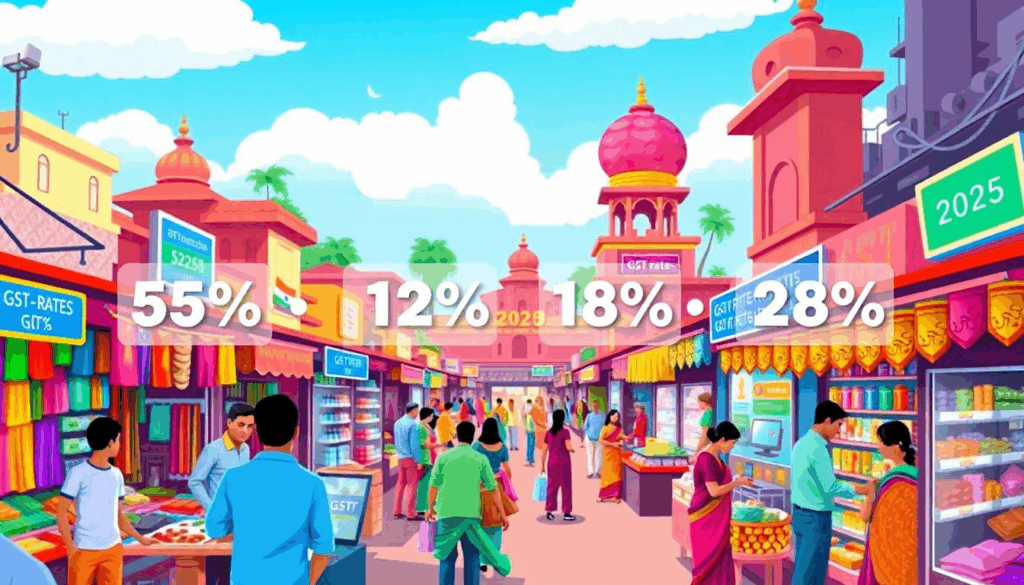Indian GST Rates 2025: A Comprehensive Guide to Future Taxation Trends

Introduction
Goods and Services Tax (GST) has been a key part of India’s tax system since 2017. It replaced many old taxes and made buying and selling easier. As India’s economy grows, so does the need to adapt GST policies. Understanding what GST rates might look like in 2025 can help businesses and consumers plan better. Several factors, like economic health and global trends, will shape these future rates. This article explores what we can expect for GST in 2025 and how it could affect different sectors and your daily expenses.
Current GST Framework and Recent Reforms
Overview of the Existing GST Structure
India uses a multi-tier GST system with four main slabs: 5%, 12%, 18%, and 28%. Each rate applies to specific goods and services. For example, essentials like food grains are taxed at lower rates, while luxury items fall under the highest slab. This setup aims to balance revenue and fairness across sectors. Most everyday items are taxed at the 12% or 18% slabs, with some being exempt.
Recent Changes and Amendments (up to 2024)
Over the past few years, the government has introduced several reforms. In 2022, some goods’ tax rates were lowered to boost consumption post-pandemic. There have also been moves to simplify GST filing and reduce compliance burdens for small businesses. These changes have helped streamline the process and increase compliance rates. Recent reports show that GST revenue has been steadily growing, signaling better collections and more stable finances.
Challenges and Criticisms
Despite progress, challenges remain. Many small businesses find GST compliance complex and costly. Critics argue that the current slabs sometimes lump very different items together, leading to confusion. Experts suggest that the system needs more broad-based reform to make it more transparent and easier to understand for taxpayers. Additionally, some sectors feel they are paying more than their fair share.
Factors Influencing the GST Rate Changes in 2025
Economic Growth and Fiscal Policies
As India’s economy expands, the government might adjust GST rates to maximize revenue. Faster growth could lead to slight increases in rates, especially in luxury sectors. Conversely, if the economy slows or faces hurdles, rates could be trimmed to stimulate spending. Managing the fiscal deficit will also influence these decisions, aiming to keep public finances in check.
Sectoral Impact and Consumer Behavior
Different sectors influence GST rate movements. For instance, real estate, telecom, and apparel might see revisions to support industry growth. Meanwhile, consumer habits are shifting towards online shopping and digital payments. These trends push policymakers to rethink how GST applies, especially with e-commerce booming. If consumers start buying more luxury goods, higher GST on those items might be considered.
International Trends and Policy Comparisons
Globally, many countries have similar value-added tax systems. For example, Canada and Australia adjust their VAT based on economic needs. India can learn from these systems, adopting features like simplified rates or exemptions for essential goods. These lessons can help develop a more balanced GST structure by 2025.
Predicted GST Rate Structure for 2025
Expected Tax Slabs and Classifications
Most experts believe the current four slabs might stay, but some could be swapped or combined. For example, the 12% and 18% rates could be merged into a single rate to simplify compliance. There’s also talk of introducing a lower slab for basic essentials, possibly around 3% or 4%. Meanwhile, luxury and sin goods might continue at 28% or be increased slightly to curb unnecessary spending.
Sector-specific Rates and Special Provisions
Real estate could see GST adjustments to promote affordable housing. Similarly, the telecom sector might face a small increase due to growing demand. For small businesses, exemptions for certain essentials will likely continue, helping keep prices low. Luxury and non-essential goods could see GST hikes to reduce overspending and boost government revenue.
Rationalization and Simplification Measures
The Indian government has expressed interest in making GST more straightforward. Expect plans to reduce multiple rate categories or introduce a single rate for most goods and services. Simplified return filing processes and clearer classifications will also likely be part of reforms aimed at easing compliance.
Implications of Future GST Rates
For Businesses
Higher GST can mean more expenses for big firms and small startups alike. Planning ahead becomes essential, especially for sectors highly affected by rate changes. Keeping accurate records and understanding new thresholds will help avoid penalties. Business owners should also explore ways to pass some costs onto consumers without losing competitiveness.
For Consumers
Price tags may get a little bigger if GST rises on daily necessities. Understanding which items will see higher taxes helps shoppers plan better. For example, luxury buyers might face higher costs, while essential goods may stay affordable. Smart consumers will compare prices and shop during sales or discounts to save money.
For the Economy
GST reforms directly impact inflation rates and economic growth. Slight rises in rates could boost government revenue, helping fund new projects. However, sharp increases might slow consumption. Economists estimate that a balanced GST system in 2025 can support steady growth without inflation spikes. It’s a delicate dance between collecting enough revenue and keeping the economy vibrant.
Expert Opinions and Industry Insights
Leading tax experts believe that gradual adjustments in GST are necessary for long-term stability. Many economists suggest refining the slabs and reducing grey areas for better compliance. Industry leaders from sectors like retail and real estate foresee benefits if GST becomes more streamlined. They stress that clear policies help businesses plan investments wisely, which boosts overall growth.
Actionable Tips for Stakeholders
- Businesses should keep updated on proposed GST changes through official channels.
- Maintain accurate records to ensure smooth compliance and avoid penalties.
- Consider consulting tax professionals for effective planning.
- Stay connected with government notifications and industry associations for latest developments.
- Prepare for potential rate shifts by adjusting pricing, inventory, and supply chain strategies proactively.
Conclusion
GST rates in India are expected to see some notable changes by 2025. While the government aims to simplify and rationalize the system, sectors and consumers will need to adapt. Businesses should plan ahead for possible rate fluctuations, and consumers can stay alert to emerging price changes. Understanding these trends helps everyone participate actively in the economy. As India’s tax system evolves, staying informed will be your best tool for navigating future complexities and opportunities in the Indian market.
